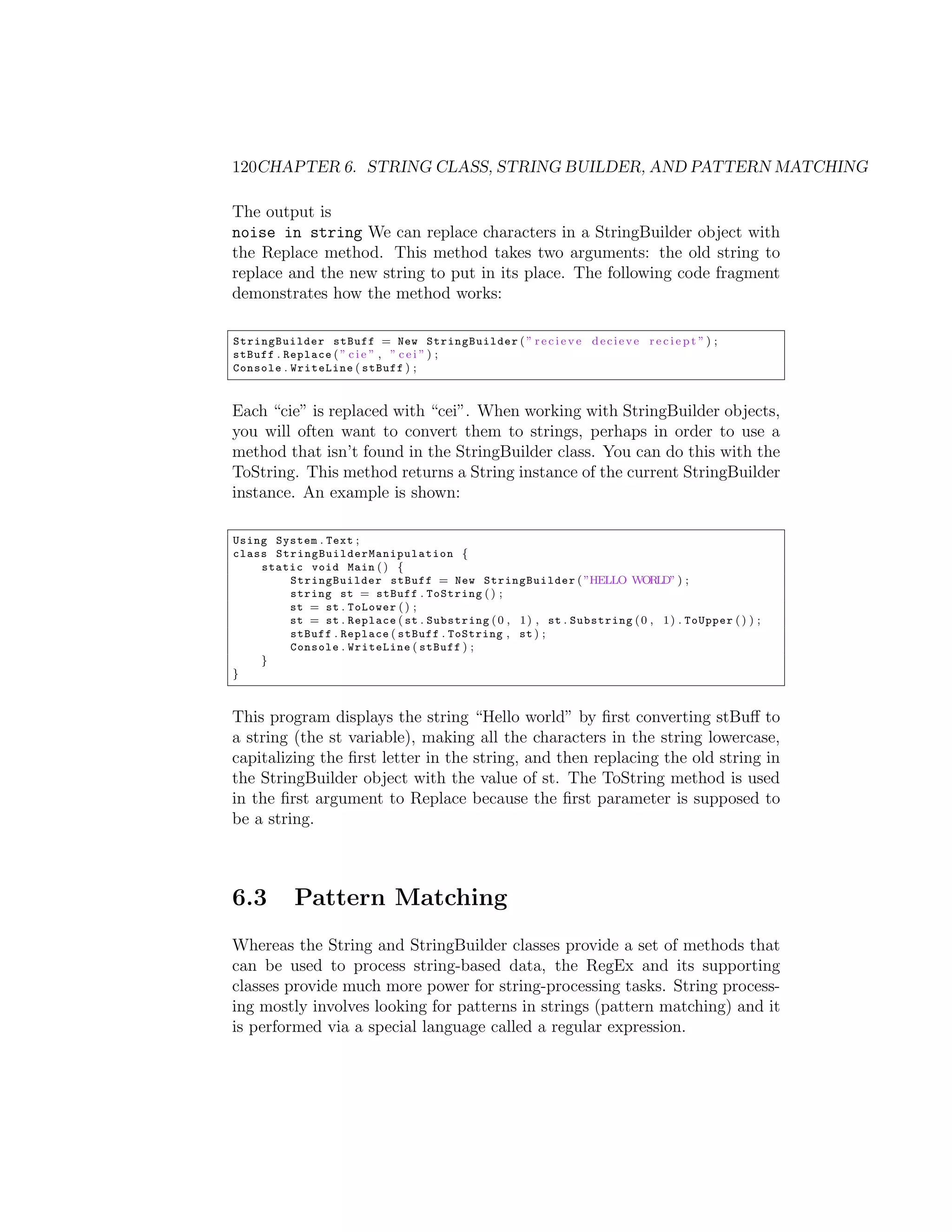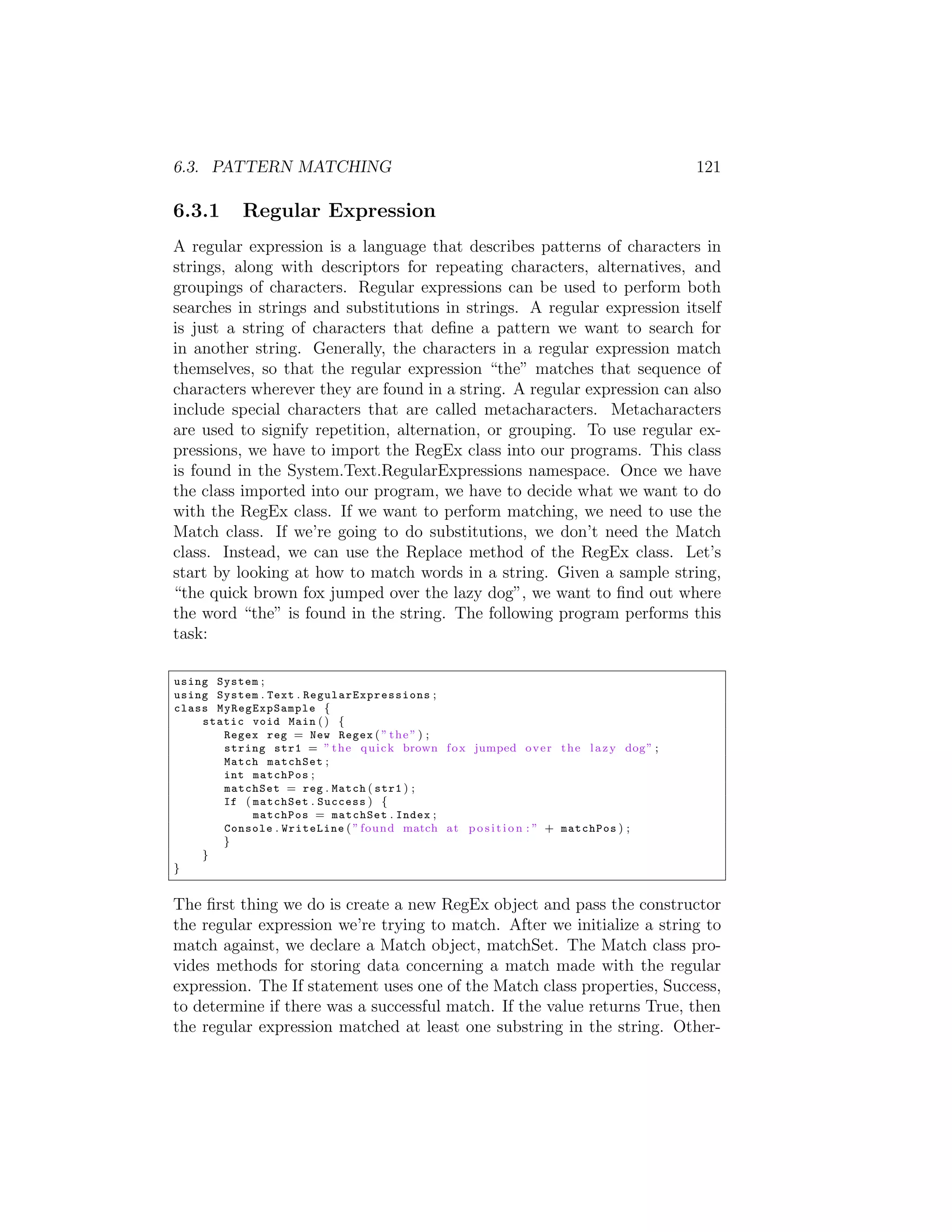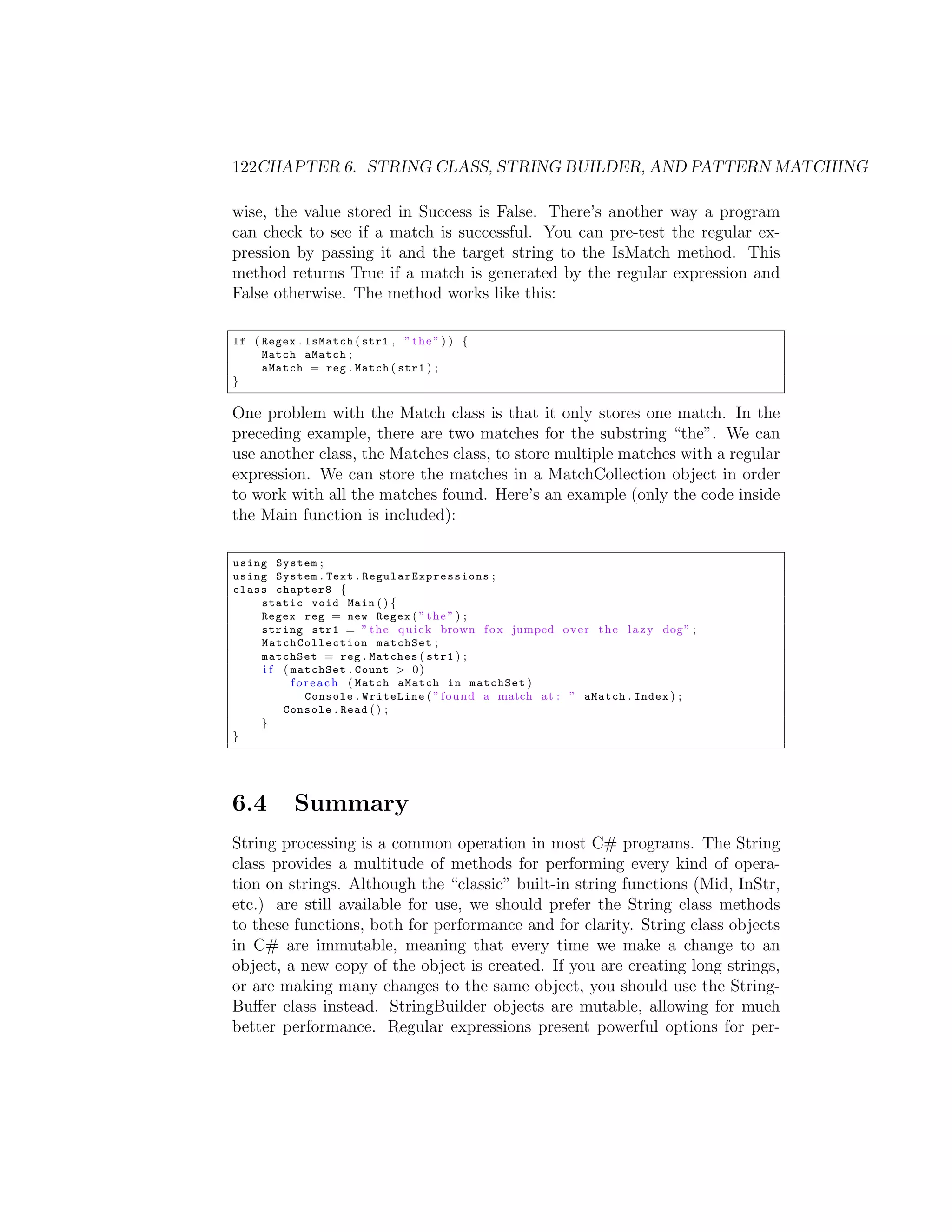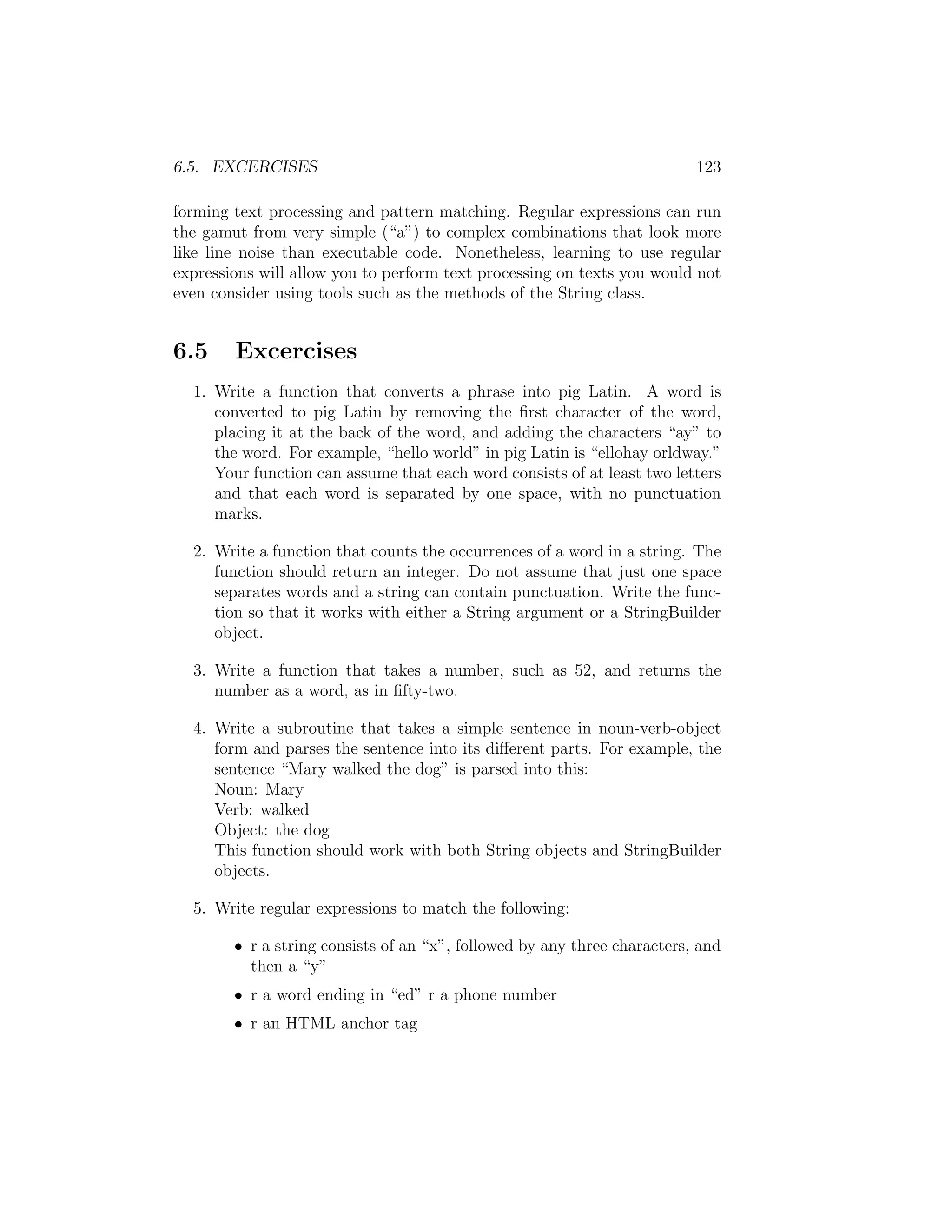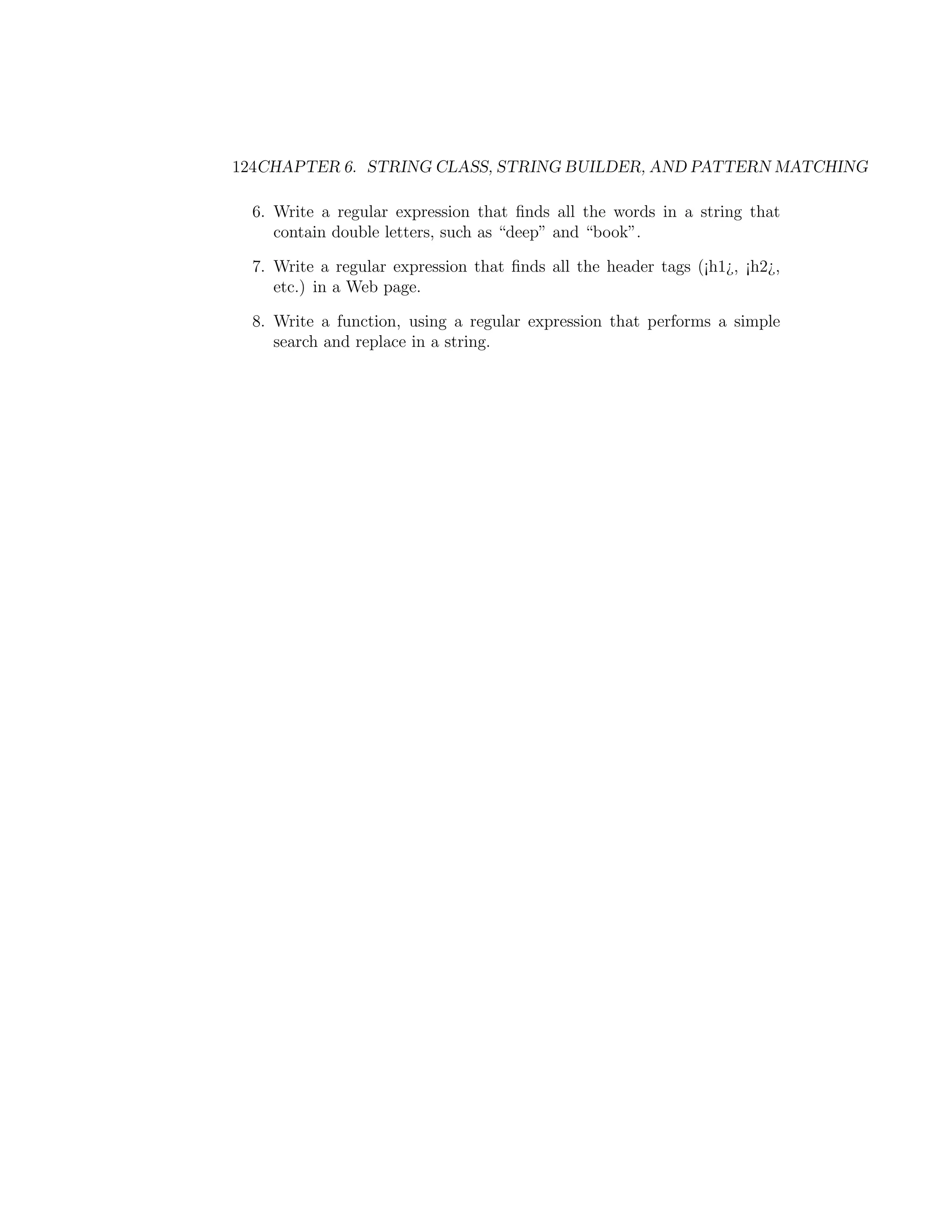This document provides an overview of strings and string processing in C#. It discusses the String class and how strings are implemented as objects in C#. Key methods of the String class like Length, IndexOf, Substring, Split, and Join are described. Algorithms for splitting a string into words and joining an array into a string are presented. Methods for comparing strings like Equals and CompareTo are also covered.
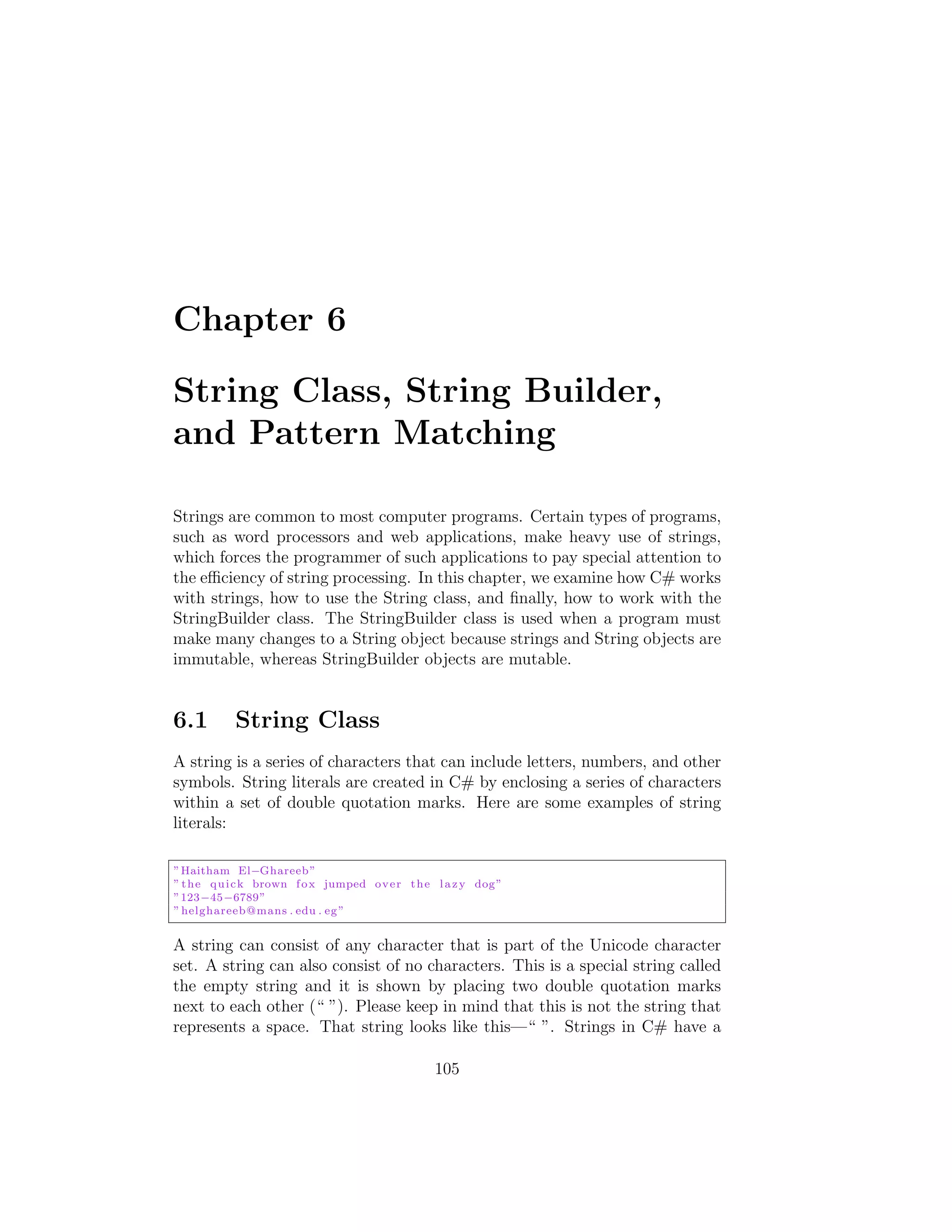
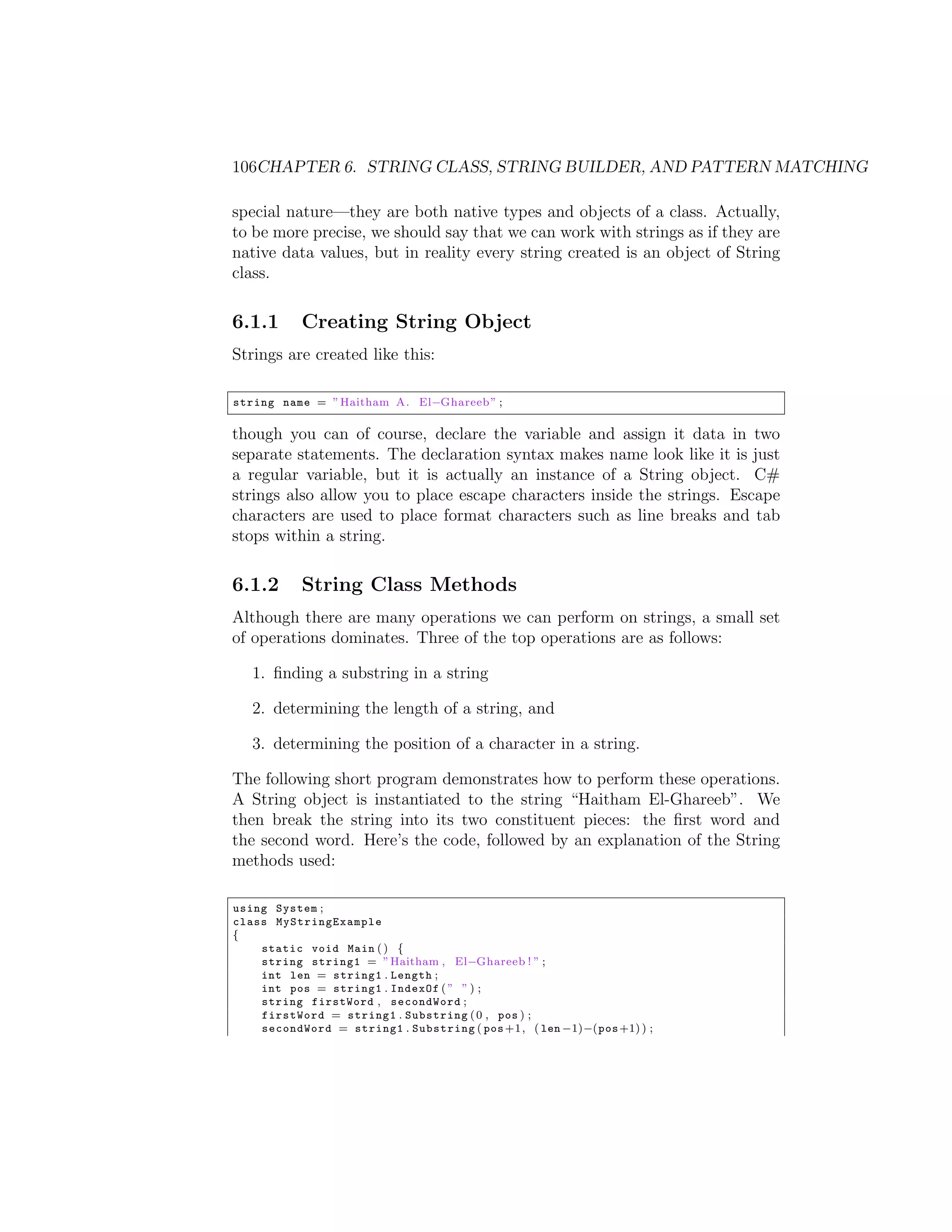
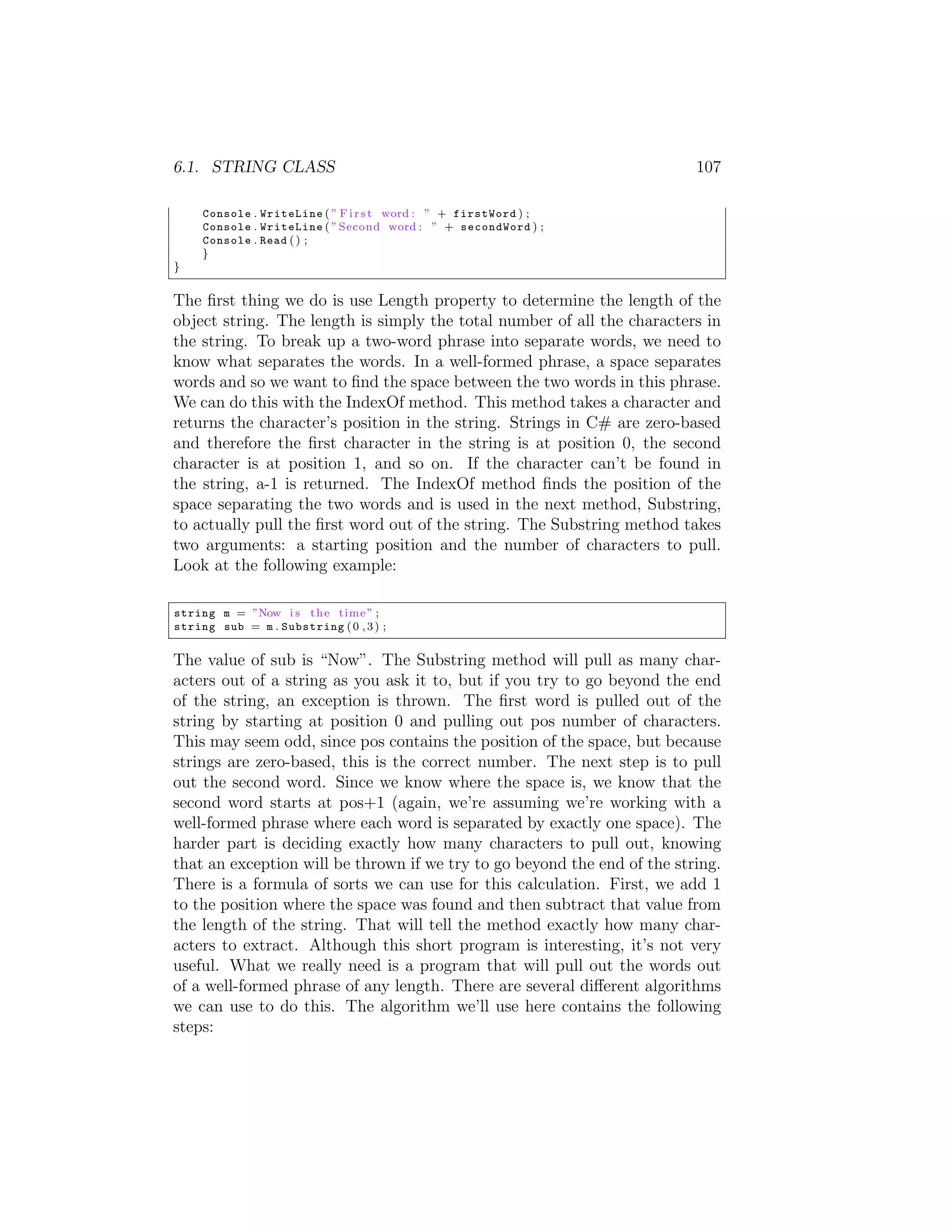
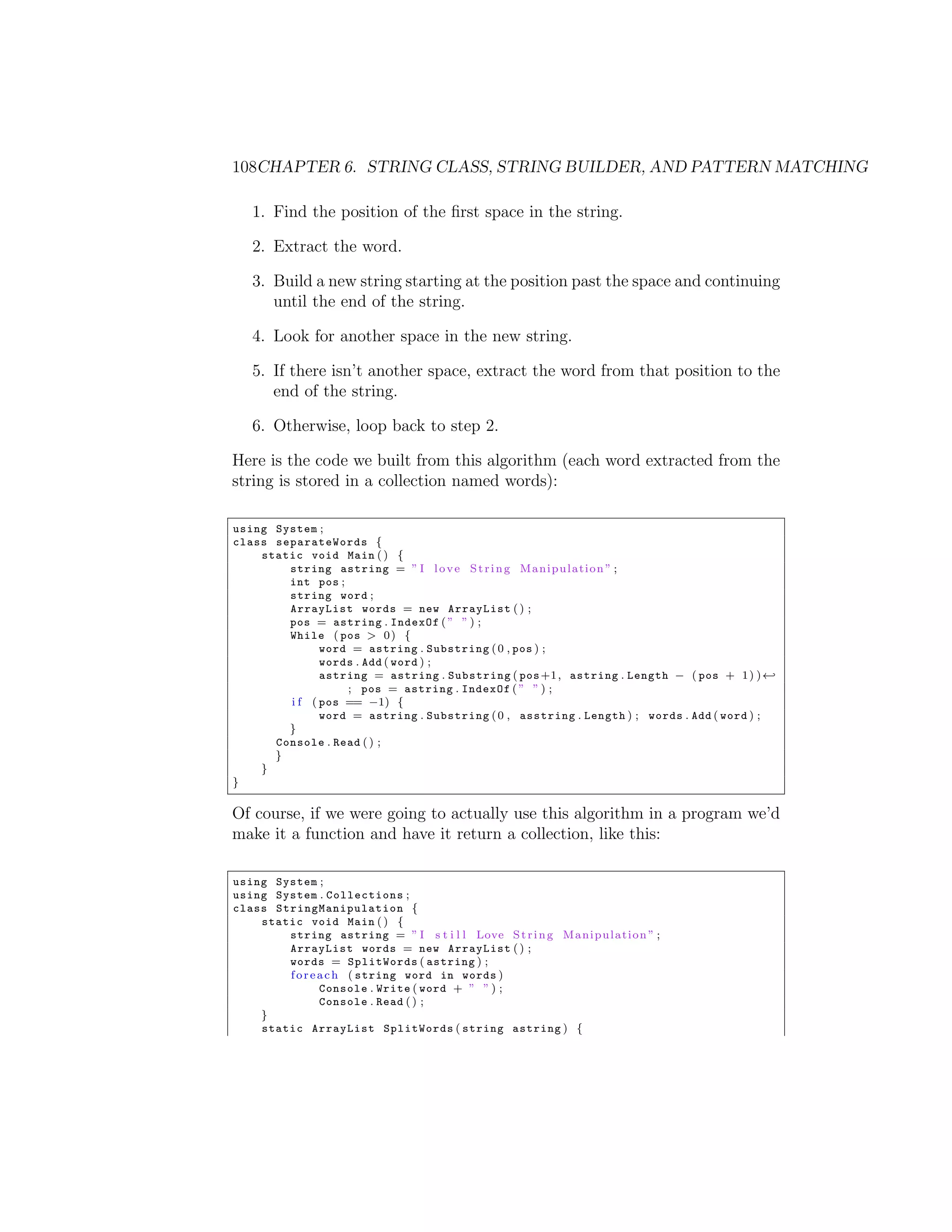
![6.1. STRING CLASS 109 string [ ] ws = new string [ astring . Length 1 ] ; ArrayList words = new ArrayList ( ) ; int pos ; string word ; pos = astring . IndexOf ( ” ” ) ; w h i l e ( pos > 0 ) { word = astring . Substring ( 0 , pos ) ; words . Add ( word ) ; astring = astring . Substring ( pos +1 , astring . Length (pos +1) ) ; i f ( pos == 1) { word = astring . Substring ( 0 , astring . Length ) ; words . Add ( word ) ; } } return words ; } } It turns out, though, that the String class already has a method for splitting a string into parts (the Split method) as well as a method that can take a data collection and combine its parts into a string (the Join method). 6.1.3 Join and Split Methods Breaking up strings into individual pieces of data is a very common function. Many programs, from Web applications to everyday o ce applications, store data in some type of string format. To simplify the process of breaking up strings and putting them back together, the String class provides two meth- ods to use: the Split method for breaking up strings and the Join method for making a string out of the data stored in an array. The Split method takes a string, breaks it into constituent pieces, and puts those pieces into a String array. The method works by focusing on a separating character to determine where to break up the string. In the example in the last section, the Split- Words function always used the space as the separator. We can specify what separator to look for when using the Split method. In fact, the separator is the first argument to the method. The argument must come in the form of a char array, with the first element of the array being the character used as the delimiter. Many application programs export data by writing out strings of data separated by commas. These are called comma-separated value strings or CSVs for short. Some authors use the term comma-delimited. A comma- delimited string looks like this: "Haitham, El-Ghareeb, Information Systems Department, Faculty of Computers and Information Sciences, Mansoura University, Egypt,35516" Each logical piece of data in this string is separated by a comma. We can put each of these logical pieces into an array using the Split method like this:](https://image.slidesharecdn.com/04-string-121021190457-phpapp01/75/LectureNotes-04-DSA-5-2048.jpg)
![110CHAPTER 6. STRING CLASS, STRING BUILDER, AND PATTERN MATCHING string data = ” Haitham , El Ghareeb , I n f o r m a t i o n Systems Department , - F a c u l t y o f Computers and I n f o r m a t i o n S c i e n c e s , Mansoura U n i v e r s i t y , - Egypt , 3 5 5 1 6 ” ; string [ ] sdata ; char [ ] delimiter = new char [ ] { ' , ' } ; sdata = data . Split ( delimiter , data . Length ) ; Now we can access this data using standard array techniques: f o r e a c h ( string word in sdata ) Console . Write ( word + ” ” ) ; There is one more parameter we can pass to the Split method—the number of elements we want to store in the array. For example, if I want to put the first string element in the first position of the array and the rest of the string in the second element, I would call the method like this: sdata = data . Split ( delimiter , 2 ) ; The elements in the array are: • 0th element-Haitham • 1st element-El-Ghareeb, Information Systems Department, Faculty of Computers and Information Sciences, Mansoura University, Egypt,35516 We can go the other way, from an array to a string, using the Join method. This method takes two arguments:the original array and a character to sepa- rate the elements. A string is built consisting of each array element followed by the separator element. We should also mention that this method is often called as a class method, meaning we call the method from the String class itself and not from a String instance. Here’s an example using the same data we used for the Split method: using System ; class JoinString { static void Main ( ) { string data = ” Haitham , El Ghareeb , I n f o r m a t i o n Systems Department - , F a c u l t y o f Computers and I n f o r m a t i o n S c i e n c e s , Mansoura - U n i v e r s i t y , Egypt , 3 5 5 1 6 ” ; string [ ] sdata ; char [ ] delimiter = new char [ ] { ' , ' } ; sdata = data . Split ( delimiter , data . Length ) ; f o r e a c h ( string word in sdata ) Console . Write ( word + ” ” ) ; string joined ; joined = String . Join ( ' , ' , sdata ) ; Console . Write ( joined ) ; } }](https://image.slidesharecdn.com/04-string-121021190457-phpapp01/75/LectureNotes-04-DSA-6-2048.jpg)
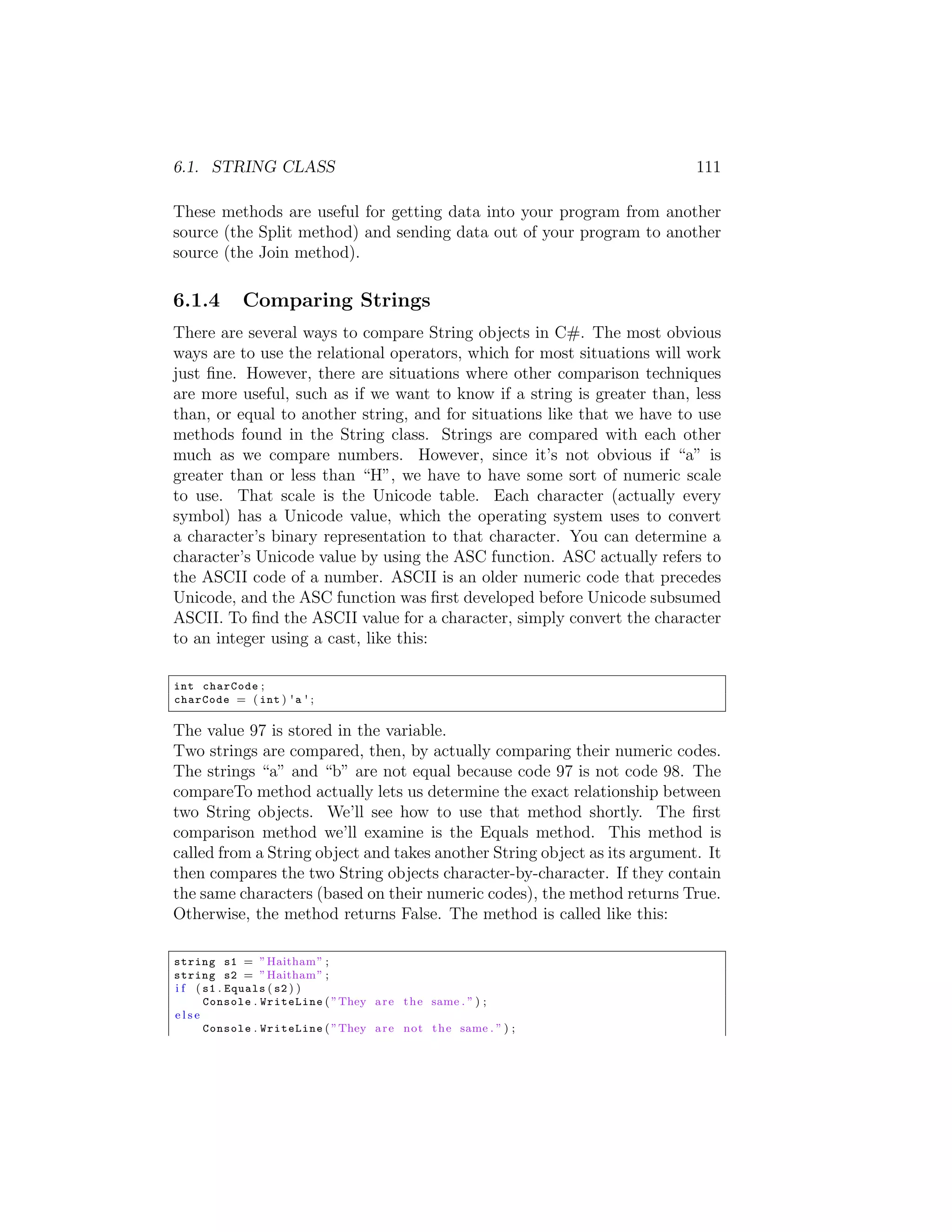
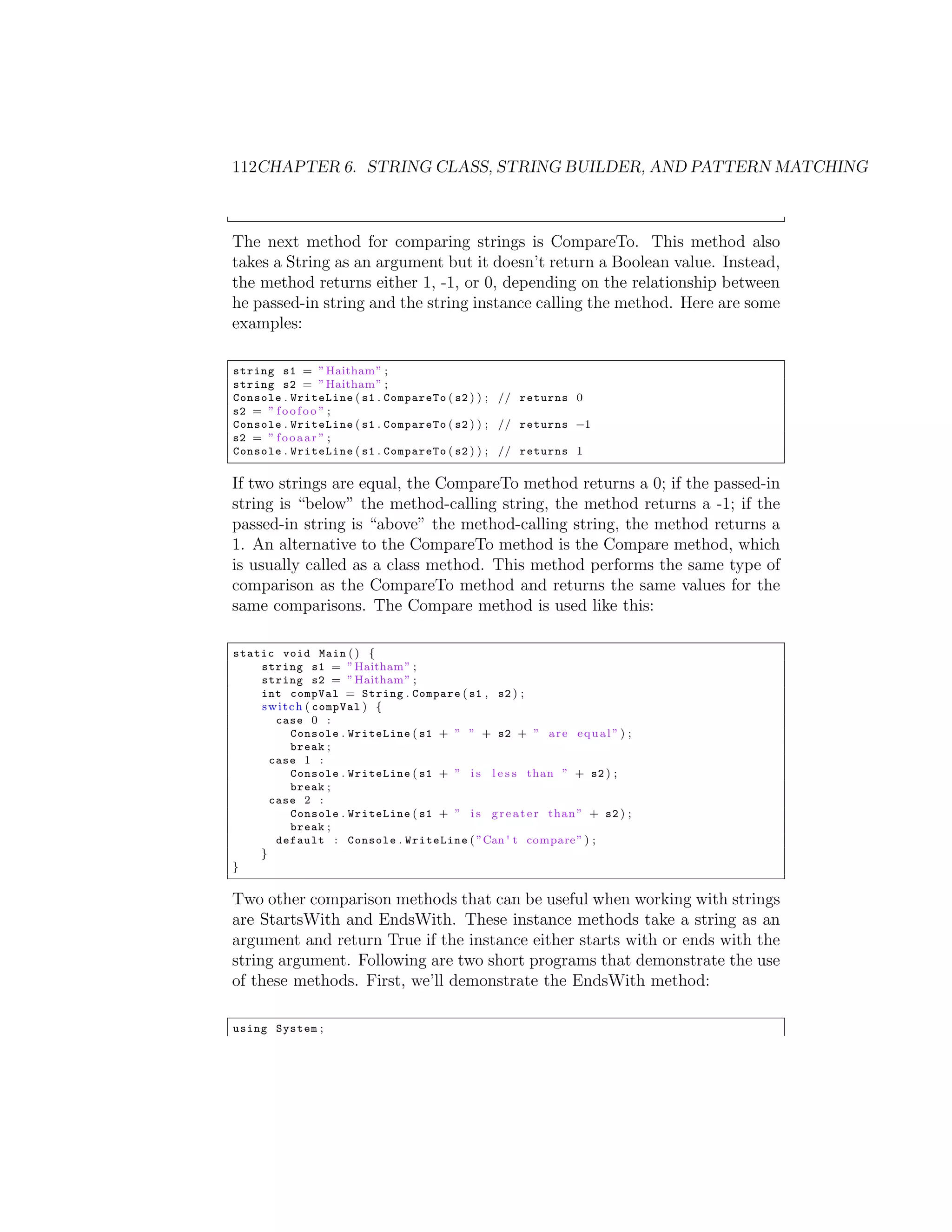
![6.1. STRING CLASS 113 using System . Collections ; class S t r i n g C o m p a r i s o n { static void Main ( ) { string [ ] nouns = new string [ ] { ” a p p l e s ” , ” o r a n g e s ” , ” banana ” , ” c h e r r y ” - , ” tomatoes ” } ; ArrayList pluralNouns = new ArrayList ( ) ; f o r e a c h ( string noun in nouns ) i f ( noun . EndsWith ( ” s ” ) ) pluralNouns . Add ( noun ) ; f o r e a c h ( string noun in pluralNouns ) Console . Write ( noun + ” ” ) ; } } First, we create an array of nouns, some of which are in plural form. Then we loop through the elements of the array, checking to see if any of the nouns are plurals. If so, they’re added to a collection. Then we loop through the collection, displaying each plural. We use the same basic idea in the next program to determine which words start with the prefix “tri”: using System ; using System . Collections ; class StringEndings { static void Main ( ) { string [ ] words = new string [ ] { ” t r i a n g l e ” , ” d i a g o n a l ” , ” t r i m e s t e r ” , ” - bifocal ” , ” triglycerides ” }; ArrayList triWords = new ArrayList ( ) ; f o r e a c h ( string word in words ) i f ( word . StartsWith ( ” t r i ” ) ) triWords . Add ( word ) ; f o r e a c h ( string word in triWords ) Console . Write ( word + ” ” ) ; } } 6.1.5 String Manipulation String processing usually involves making changes to strings. We need to insert new characters into a string, remove characters that don’t belong any- more, replace old characters with new characters, change the case of certain characters, and add or remove space from strings, just to name a few opera- tions. There are methods in the String class for all of these operations, and in this section we’ll examine them. We’ll start with the Insert method. This method inserts a string into another string at a specified position. Insert returns a new string. The method is called like this: String1 = String0 . Insert ( Position , String )](https://image.slidesharecdn.com/04-string-121021190457-phpapp01/75/LectureNotes-04-DSA-9-2048.jpg)
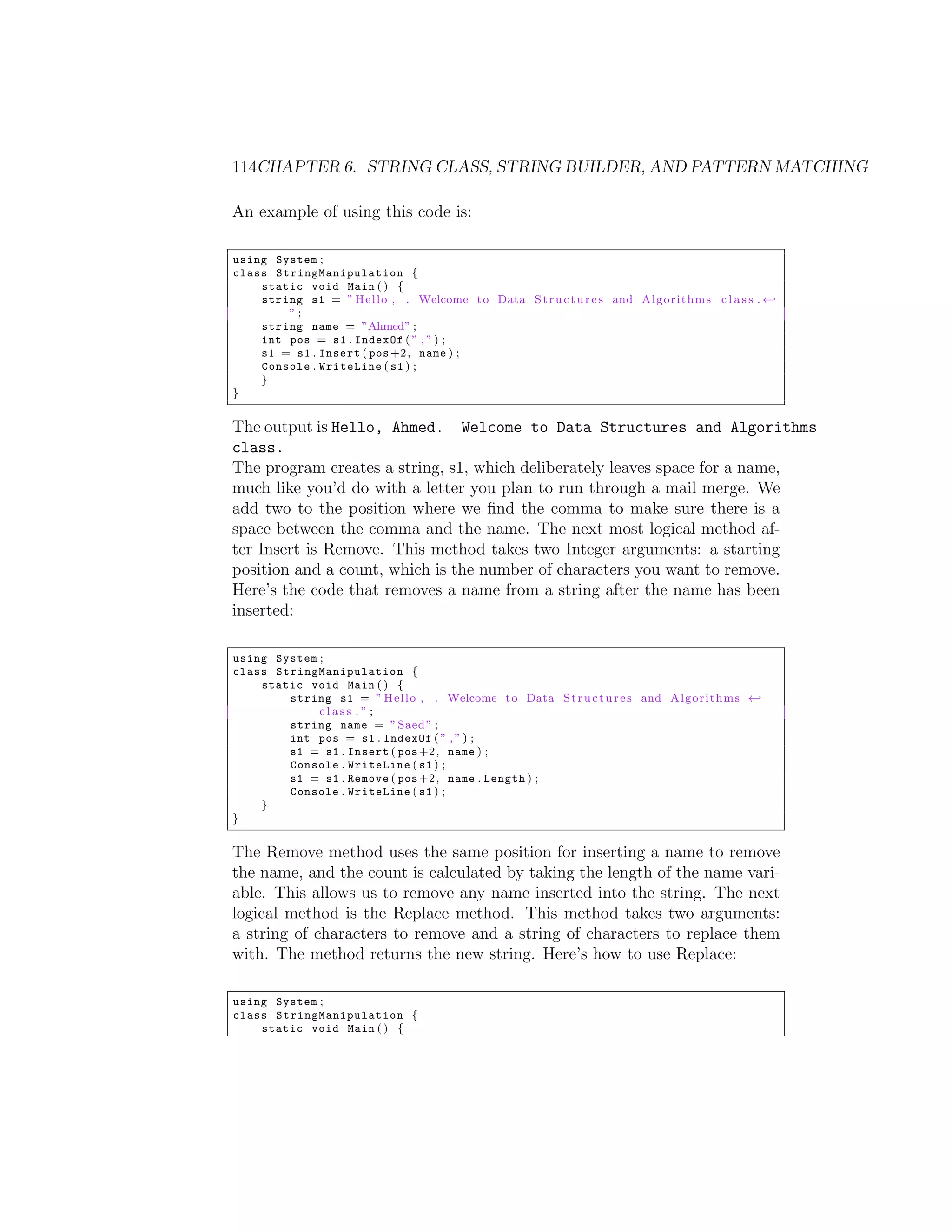
![6.1. STRING CLASS 115 string [ ] words = new string [ ] { ” r e c i e v e ” , ” d e c i e v e ” , ” r e c i e p t ” } ; for ( int i = 0 ; i <= words . GetUpperBound ( 0 ) ; i++) { words [ i ] = words [ i ] . Replace ( ” c i e ” , ” c e i ” ) ; Console . WriteLine ( words [ i ] ) ; } } } The only tricky part of this code is the way the Replace method is called. Since we’re accessing each String object via an array element, we have to use array addressing followed by the method name, causing us to write this fragment: words ( index ) . Replace ( ” c i e ” , ” c e i ” ) ; There is no problem with doing this, of course, because the compiler knows that words(index) evaluates to a String object. When displaying data from our programs, we often want to align the data within a printing field in order to line the data up nicely. The String class includes two methods for perform- ing this alignment: PadLeft and PadRight. The PadLeft method right-aligns a string and the PadRight method left-aligns a string. For example, if you want to print the word “Hello” in a 10-character field right-aligned, you would write this: string s1 = ” H e l l o ” ; Console . WriteLine ( s1 . PadLeft ( 1 0 ) ) ; Console . WriteLine ( ” world ” ) ; The output is: Hello world Here’s an example using PadRight: string s1 = ” Haitham ” ; string s2 = ” Abdel Monem” ; string s3 = ” El Ghareeb ” ; Console . Write ( s1 . PadLeft ( 1 0 ) ) ; Console . WriteLine ( s2 . PadLeft ( 1 0 ) ) ; Console . Write ( s3 . PadLeft ( 1 0 ) ) ; Console . WriteLine ( s2 . Padleft ( 1 0 ) ) ; We end this section with a discussion of the Trim and TrimEnd methods. When working with String objects, they sometimes have extra spaces or other formatting characters at the beginning or at the end of the string. The Trim and TrimEnd methods will remove spaces or other characters from either end](https://image.slidesharecdn.com/04-string-121021190457-phpapp01/75/LectureNotes-04-DSA-11-2048.jpg)
![116CHAPTER 6. STRING CLASS, STRING BUILDER, AND PATTERN MATCHING of a string. You can specify either a single character to trim or an array of characters. If you specify an array of characters, if any of the characters in the array are found, they will be trimmed from the string. Let’s first look at an example that trims spaces from the beginning and end of a set of string values: using System ; class S t r i n g M a n i p u l a t i o n { static void Main ( ) { string [ ] names = new string [ ] { ” Haitham ” , ” Mohamed ” , ”Ahmed ” , - ” Saed ” } ; Console . WriteLine ( ) ; showNames ( names ) ; Console . WriteLine ( ) ; trimVals ( names ) ; Console . WriteLine ( ) ; showNames ( names ) ; } static void showNames ( string [ ] arr ) { for ( int i = 0 ; i <= arr . GetUpperBound ( 0 ) ; i++) Console . Write ( arr [ i ] ) ; } static void trimVals ( string [ ] arr ) { char [ ] charArr = new char [ ] { ' ' } ; for ( int i = 0 ; i<= arr . GetUpperBound ( 0 ) ; i++) { arr [ i ] = arr [ i ] . Trim ( charArr [ 0 ] ) ; arr [ i ] = arr [ i ] . TrimEnd ( charArr [ 0 ] ) ; } } } 6.2 String Builder The StringBuilder class provides access to mutable String objects. Objects of the String class are immutable, meaning that they cannot be changed. Every time you change the value of a String object, a new object is created to hold the value. StringBuilder objects, on the other hand, are mutable. When you make a change to a StringBuilder object, you are changing the original object, not working with a copy. In this section, we discuss how to use the StringBuilder class for those situations where many changes are to be to the String objects in your programs. The StringBuilder class is found in the System.Text namespace so you must import this namespace into your program before you can use StringBuilder objects. You can construct a StringBuilder object in one of three ways. The first way is to create the object using the default constructor: StringBuilder stBuff1 = new StringBuilder ( ) ;](https://image.slidesharecdn.com/04-string-121021190457-phpapp01/75/LectureNotes-04-DSA-12-2048.jpg)
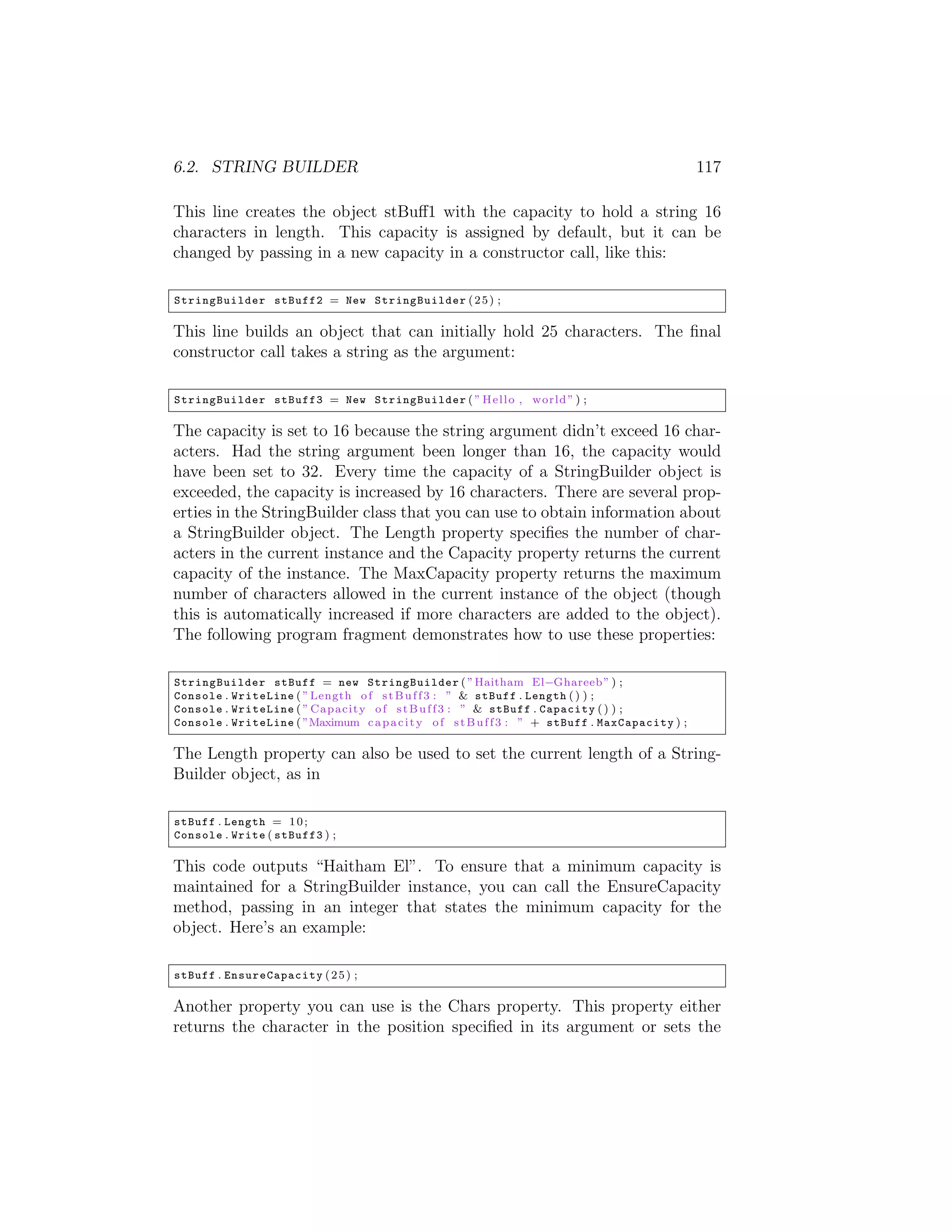
![118CHAPTER 6. STRING CLASS, STRING BUILDER, AND PATTERN MATCHING character passed as an argument. The following code shows a simple example using the Chars property. StringBuilder stBuff = New StringBuilder ( ” Haitham El Ghareeb ” ) ; If ( stBuff . Chars ( 0 ) <> ”D” ) stBuff . Chars ( 0 ) = ”D” ; 6.2.1 Modifying StringBuilder Objects We can modify a StringBuilder object by appending new characters to the end of the object, inserting characters into an object, replacing a set of characters in an object with di↵erent characters, and remove characters from an object. You can add characters to the end of a StringBuilder object by using the Append method. This method takes a string value as an argument and concatenates the string to the end of the current value in the object. The following program demonstrates how the Append method works: Using System . Text ; class S t r i n g B u i l d e r M a n i p u l a t i o n { static void Main ( ) { StringBuilder stBuff As New StringBuilder ( ) ; String [ ] words = new string [ ] { ”now ” , ” i s ” , ” t h e ” , ” time ” , ” - f o r ” , ” a l l ” , ” good ” , ”men ” , ” t o ” , ”come ” , ” t o ” , ” t h e ” , - ” aid ” , ” o f ” , ” t h e i r ” , ” party ”} For ( int i = 0 ; i <= words . GetUpperBound ( 0 ) ; i++) stBuff . Append ( words ( index ) ) ; Console . WriteLine ( stBuff ) ; } } The output is, of course Now is the time for all good men to come to the aid of their party A formatted string can be appended to a StringBuilder object. A formatted string is a string that includes a format specification embedded in the string. There are too many format specifications to cover in this section, so we’ll just demonstrate a common specification. We can place a formatted number within a StringBuilder object like this: Using System . Text ; class S t r i n g B u i l d e r M a n i p u l a t i o n { static void Main ( ) { StringBuilder stBuff = New StringBuilder ( ) ; Console . WriteLine ( ) ; stBuff . AppendFormat ( ”Your o r d e r i s f o r {0000} w i d g e t s . ” , 2 3 4 ) ; stBuff . AppendFormat ( ” nWe have {0000} w i d g e t s l e f t . ” , 1 2 ) ; Console . WriteLine ( stBuff ) ; }](https://image.slidesharecdn.com/04-string-121021190457-phpapp01/75/LectureNotes-04-DSA-14-2048.jpg)
![6.2. STRING BUILDER 119 } The format specification is enclosed within curly braces that are embedded in a string literal. The data after the comma is placed into the specification when the code is executed. Next is the Insert method. This method allows us to insert a string into the current StringBuilder object. The method can take up to three arguments. The first argument specifies the position to begin the insertion. The second argu- ment is the string you want to insert. The third argument, which is optional, is an integer that specifies the number of times you want to insert the string into the object. Here’s a small program that demonstrates how the Insert method is used: Using System . Text ; class S t r i n g B u i l d e r M a n i p u l a t i o n { static void Main ( ) { StringBuilder stBuff = New StringBuilder ( ) ; stBuff . Insert ( 0 , ” H e l l o ” ) ; stBuff . Append ( ” world ” ) ; stBuff . Insert ( 5 , ” , ” ) ; Console . WriteLine ( stBuff ) ; char chars [ ] = new char [ ] { ' t ' , ' h ' , ' e ' , ' r ' , 'e ' } ; stBuff . Insert ( 5 , ” ” & chars ) ; Console . WriteLine ( stBuff ) ; } } The output is Hello, world Hello there, world The following program utilizes the Insert method using the third argument for specifying the number of insertions to make: StringBuilder stBuff = New StringBuilder ( ) ; stBuff . Insert ( 0 , ” and on ” , 6 ) ; Console . WriteLine ( stBuff ) ; The output is and on and on and on and on and on and on The StringBuilder class has a Remove method for removing characters from a StringBuilder object. This method takes two arguments: a starting position and the number of characters to remove. Here’s how it works: StringBuilder stBuff = New StringBuilder ( ” n o i s e i n+++++s t r i n g ” ) ; stBuff . Remove ( 9 , 5 ) ; Console . WriteLine ( stBuff ) ;](https://image.slidesharecdn.com/04-string-121021190457-phpapp01/75/LectureNotes-04-DSA-15-2048.jpg)
